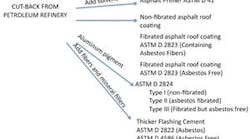Asphalt emulsions (as we discussed previously) contain very small amounts of volatile organic compounds (VOCs) and have been used in the roofing industry for decades. The virtues of clay stabilization lie in resistance to flow under heat load or fire conditions and remarkable weather resistance. However, substrates need to be clean (damp is fine), which in our business is the exception rather than the rule.
Do You Need a Primer?
Some materials require a primer, which brings us to a family of bituminous materials created from cutback, a viscous asphalt solution combined with a petroleum solvent (which is a volatile organic substance). Water-based materials cannot be used to laminate layers of bituminous felts together, while solvents are capable of diffusing through roofing felts, for example, leaving no air pockets or blisters behind. Roofing material manufacturers begin with a blend of asphalt dissolved in a petroleum solvent that they have purchased directly from a refinery.
Both the asphalt and its hydrocarbon solvent have been extracted by distillation. This combination product, marketed as non-fibered roof coating, can be transferred to pails or drums without further processing.
To produce asphalt primer starting with the purchased cutback, the roofing manufacturer just adds more solvent. The solvent of choice is mineral spirits, which has a flash point above 100 degrees F. This avoids a red label designation. Mineral spirits has a boiling range from 300-400 degrees F. This product for asphalt primer meets ASTM D41, which was originally published way back in 1917.
The main purpose of asphalt primer is to promote adhesion between asphalt-containing roof components. To do this, the primer needs to be thin (of low viscosity), so that it can penetrate dust, laitance, or a thin film of finishing oil that may exist on metal surfaces.
What Standards Should It Meet?
One of the primary tests for primer is ASTM D88 for Saybolt Viscosity, using a Zahn Cup (see above) to measure how many seconds it takes the primer to drain a cup through a standardized opening.
Currently, D41 describes a slightly thicker (more viscous) material as D41 Type I (up to 125 seconds), and a much thicker Type II material (hardly a primer) of 120 to 800 seconds.
Going back to the cutback from the refinery, various fibers and mineral fibers can be added to stabilize the roof coating. In years past, these were usually asbestos fibers that improved both surface fire resistance and weather resistance. But, because of health concerns, asbestos is rarely used today. Glass fibers tend to separate and settle in the pail during storage, so cellulose fibers may be the substitute fiber of choice. Roof coatings meeting ASTM Specification D 2823 may have asbestos, while ASTM D4479 is asbestos-free.
Taking the same refinery-furnished cutback, aluminum pigment and mineral fillers can be added to provide a reflective surface. The flakes of alumimum float to the surface as the solvent evaporates and provide a UV screen and a cooler coating. The non-fibrated aluminum coating material is covered by ASTM D2824, in which Type I is non-fibrated, Type II is asbestos fibrated, and Type III is asbestos-free.
For weatherproofing vertical surfaces where slump could be a problem, a more viscous material is used. More fibers and fillers are added to increase the viscosity, and the resulting mastic is affectionately known as flashing cement, bull, pookie, or mud. This material is widely used on horizontal surfaces for patching as well.
Using Cutbacks for Roof Maintenance
Virtually every manufacturer of bituminous and modified bituminous roofing material provides a sequence for membrane repair. This typically includes:
- Cut out and remove damaged materials such as broken blisters and loose materials in open seams.
- Apply asphalt primer several inches beyond the damaged area.
- Apply asphalt mastic followed by reinforcing fabric.
- Apply more asphalt mastic over the fabric. (This process is known as “three-course.”)
- Reapply surfacing to match the remaining membrane.
Richard (Dick) L. Fricklas was technical director emeritus of the Roofing Industry Educational Institute prior to his retirement. He is co-author of The Manual of Low Slope Roofing Systems, and continues to participate in seminars for the University of Wisconsin and RCI Inc.-The Institute of Roofing, Waterproofing, and Building Envelope Professionals. His honors include the William C. Cullen Award and Walter C. Voss Award from ASTM, the J. A. Piper Award from NRCA, and the James Q. McCawley Award from the MRCA. Dick holds honorary memberships in both ASTM and RCI Inc.
Ironically, while most of the above materials are available in 1-, 3- or 5-gallon pails from a local lumber yard, primer comes only in large containers (5 gallons or larger) to be applied by an experienced roofing contractor using a spray rig.
Why Should I Use Cold-Applied Cutbacks?
Asphaltic cutbacks offer many advantages over non-bituminous materials. These products are naturally water-repellant and resist damage from storage during freezing weather – in fact, they can be stored indefinitely as long as they’re kept in closed containers, with many available in reusable totes.
Their versatility contributes to their popularity. Only a simple brush, trowel, or spray rig is needed to apply asphaltic cutbacks, and they’re compatible with asphalt felts, fabrics, and even modified bitumens. (Caution: styrene-butadiene-styrene [SBS] modified membranes are not compatible with some cutbacks that contain too much solvent, so look for SBS-compatible labels on cutbacks and flashing cements.) Cutbacks also provide an adhesive base for sprayed roofing granule surfacings.
CORRECTION
An earlier version of this article suggested that non-fibrated roof coating thinned with mineral spirits can be used as a home-made primer and that WD-40 could be used in lieu of a primer. In fact, the former practice may violate VOC regulations and manufacturer warranties, and WD-40 acts as a release agent and should not be used for this purpose. BUILDINGS thanks the Roof Coatings Manufacturers Association (RCMA) for pointing out the errors.
Related Articles:
Prescriptions Don’t Do It All, Either
How prescriptive specifications can fail.
The Easy Road to Roof Sustainability
Extend your roof’s life and minimize waste with these fixes.
Single Ply Systems Can Be Repaired
Fixes for common single-ply roofing problems.



